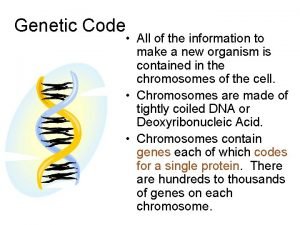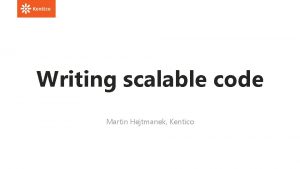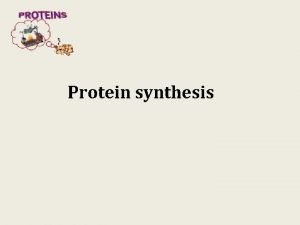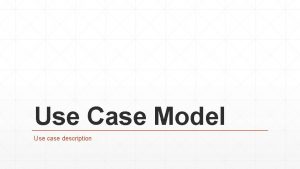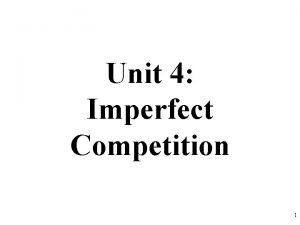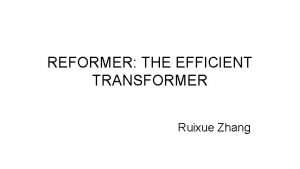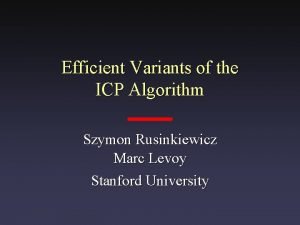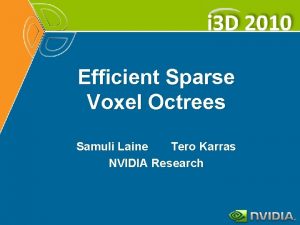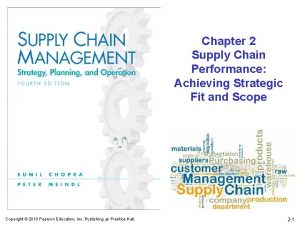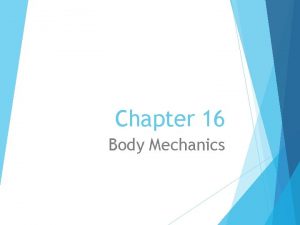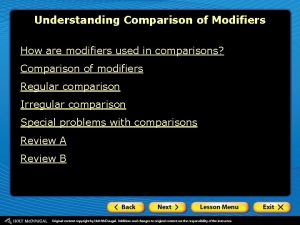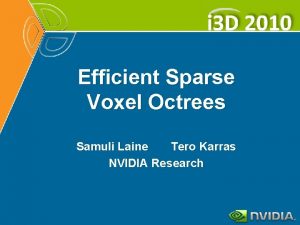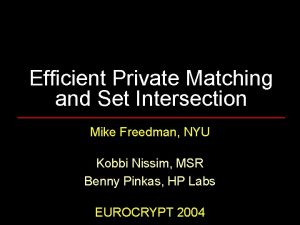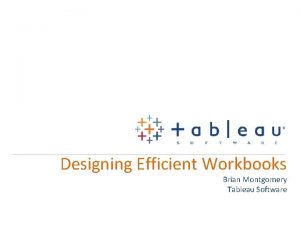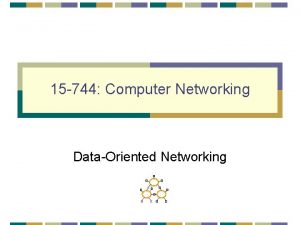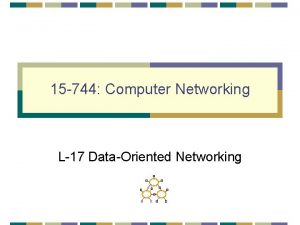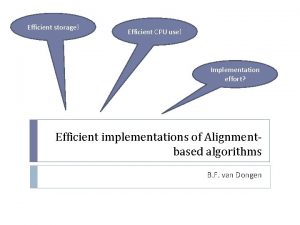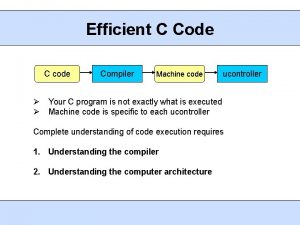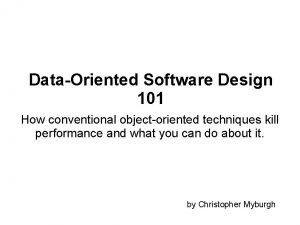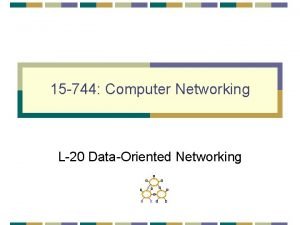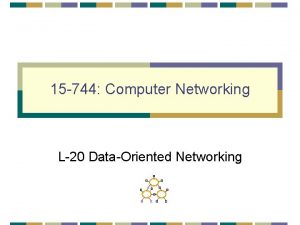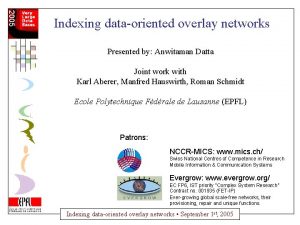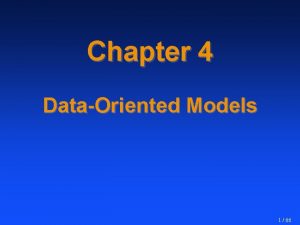Use DataOriented Design to write efficient code Alessio







































































- Slides: 71

Use Data-Oriented Design to write efficient code Alessio Coltellacci System developer @lightplay 8 on twitter Not. Bad 4 U on github 1

2

Understanding the field 3

Which program is better and why? A - Iterate by columns B - Iterate by row 4

B is X 2, 5 faster A - Iterate by columns $ time. /incorrect_loop real user sys 0 m 2. 370 s 0 m 2. 260 s 0 m 0. 080 s B - Iterate by row $ time. /correct_loop real 0 m 0. 585 s user 0 m 0. 516 s sys 0 m 0. 052 s 5

8192 * 4(float size) = 32 768 = 1 line of the matrix 6

We need to remember how CPUs work 7

The central processing unit (CPU) carries out the instructions of a computer program by performing arithmetic. 8

CPU Caches in the Big Picture CORE 1 L 1 d Li 1 CORE 3 CORE 2 L 1 d Li 1 L 1 d L 2 Li 1 CORE 4 L 1 d Li 1 L 2 L 3 MAIN MEMORY 10

MESI cache coherence protocol 11

Memory hierarchy Type Size Access time cycle CPU Analogy Registers 64/32 B 1 cycle Take something on your desk Cache L 1 32 KB ~4 Go to your printer Cache L 2 256 KB ~ 11 Change rooms Cache L 3 8 MB ~ 39 Go to your supermarket RAM depends ~ 1024 Go to another city Filesystem (SSD) depends (~4 000) Go around the world Network depends (~400 000) Go to Mars 12

Why don’t we have a big L 1 cache ? With a large cache, the latency to find an item in the cache approaches the latency of looking up in main memory. 13

Frequency of the memory bus and the performance of RAM chips didn’t increase proportionally Main Memory Bus Cache CPU Core 14

The usefulness of loop interchange Accessing an element for the first time (e. g. a 11): The processor will retrieve an entire block from memory to cache: It loads a 11, a 12, a 13, a 14, … in a L 1 d cache line L 1 cache line ~= 64 B 15

The usefulness of loop interchange A - Iterate by columns B - Iterate by rows ● Grab a chunk of 16 floats ● Modify only one ● Modify all of them ● Repeat 8192 x 8192 times ● Repeat 8192 x 8192 / 16 times The CPU has to spend time waiting for that memory to show up. The CPU always has something to work on. 16

Profiling! 17

perf Tool for Linux profiling with performance counters 18

Architecture of Linux “Perf” perf tool perf_events user space kernel space Model-specific register (MSR) hardware 19

Perf version A 20

Perf version B Frontend cycle idle 60. 21% Backend cycle idle 13. 46% Cache-misses 4 527 939 Factor 15 21

Let’s talk about Data-Oriented Design 22

We want to help the processor by preparing our data to be processed in a more efficient way. 23

Memory access pattern Prefer sequential access rather than random access to benefit from prefetched data in the cache. NOTE: Remember the first example 25

Use packed contiguous chunks of memory for data structures 26

Data locality Keep data in the order that you process it. 27

Use algorithms that process a single task at a time. It’s easier to profile with micro benchmarks 28

“Efficiency through algorithms. Performance through data structures. ” Chandler Carruth, Cpp. Con 2014 29

Let’s talk about data structures 30

Use pointers to the next element The pointer might point into memory that isn't in cache. 31

Linked. List = spread memory 1 2 (always a performance bug) Elem 2: 0 x 01000 Elem 1: 0 x 0000 3 Elem 3: 0 x 08000 n Elem n: 0 x 08102 32

C++ benchmark - std: : vector VS std: : list Intel Core i 7 Q 820 @ 1. 73 GHz GCC 4. 7. 2 with -02 and -march=native 33

C++ benchmark - std: : vector VS std: : list 34

Using generic data structure is slow when runtime polymorphism (dynamic dispatch) is used. 35

36

Use Plain Old Data ● Simple structs with all data in itself. ● Separe the logic from your data. ● Try to avoid pointers, virtual functions, inheritance, . . . 37

Hot / Cold splitting ● Drops useless info ● Fits better in cache ● Reduces cache misses ● Less data to read and less work to do! 38

Data-Oriented hash map ● No buckets! ● Table stored as contiguous elements in memory. ● Collision algorithm should find a slot in the same cache line. ● Keep the key and values small. 39

https: //github. com/sozu-proxy/sozu 40

At the beginning, for each request we allocated a new vector. 41

42

A lot of time spent allocating memory and not processing the requests 43

So we switched to a SLAB Pre-allocated storage for a uniform data type. 44

BTW SLAB is possible in Java with sun. misc. Unsafe or Byte. Buffer https: //github. com/Richard. Warburton/slab 45

46

Workers use CPU Affinity Enable the binding of a process to a CPU core. pthread_setaffinity_np That reduces the cache miss rates if you use the same L 1 d/L 2 all the time. 47

Yeah but I use a language with a Runtime System. . . Can I use Data-Oriented Design? 62

Data-Oriented Design with Java. Script C++ C Rust 63

Demo with Node. Js 9. 3. 0 TARGET VELOCITY_VECTO R CELL 64

Let’s do an OOP version ● Use a JS object to represent an Entity. ● Attach an update method to their prototype. ● Store all different entities in the same JS array. 65

V 1 - Common and legit code 66

https: //github. com/Not. Bad 4 U/dod_cell_system/blob/master/cell_system. js 67

time node cell_system. js user sys 31. 08 s! 0. 11 s 68

The problems with this design ● Accessing the update method in the prototype has a cost. ● Separate allocation with new Cell(. . . ) ● Run-Time Type Information 69

Profiling! 70

Profile to understand what is happening node --prof cell_system. js node --prof-process your. log 71

Version 1 72

Let’s try to optimize this 73

V 2 - Data- Oriented Design version 74

https: //github. com/Not. Bad 4 U/dod_cell_system/blob/master/cell_system_optimised. js 75

time node cell_dod_system. js user sys 4. 98 s! 0 s 76

NOTE: Lower is better 77

Profiling (to be sure)! 78

perf stat -e cache-misses, L 1 -dcache-load-misses node *. js Not optimized Data-Oriented design cache-misses 233 295 915 5 333 440 L 1 -dcache-loadmisses 2 841 872 571 353 663 078 Miss: factor 43 L 1 miss: factor 8 79

Data-Oriented Design version We spend most of the time updating the data and not waiting to accessing it. 80

81

● Profile your code often. ● Use contiguous, dense, cache-oriented data structures. ● Know how your languages and runtime systems works 82

Furthermore, we have SIMD-friendly and parallel computing data layouts. 83

Go further ● Impact Of Virtualization ● Optimizing Page Table Access (TLB) ●. . . 84

Now you know where to look and profile 85

For more information ● What every Programmer Should know About Memory by Ulrich Drepper ● http: //www. dataorienteddesign. com/site. php ● Data Oriented Design Resources ● Data-Oriented Design and C++ by Mike Acton at Cpp. Con 2014 ● C++ in Huge AAA Games by Nicolas Fleury at Cpp. Con 2014 86

15€ Coupon Clever Cloud: devfest. Toulouse 2018 https: //docs. google. com/pres<entation/d/14 IBNbj. Yn. CYr. Nd. Mq 6 hn. Yd Uc 2 GLbrh. S 3 godn 6 Nv 93 fmn. A/edit? usp=sharing 87
 Productively efficient vs allocatively efficient
Productively efficient vs allocatively efficient Allocative efficiency
Allocative efficiency C b a d
C b a d Productively efficient vs allocatively efficient
Productively efficient vs allocatively efficient Productively efficient vs allocatively efficient
Productively efficient vs allocatively efficient Angela alessio robles
Angela alessio robles Alessio patalano
Alessio patalano Anagrafe di civitavecchia
Anagrafe di civitavecchia Cpia 4 lazio
Cpia 4 lazio Loading or coagulation
Loading or coagulation Dopolavoro ferroviario
Dopolavoro ferroviario Alessio bocci
Alessio bocci Alessio rocchi
Alessio rocchi Alessio mazzotta
Alessio mazzotta Alessio
Alessio Code commit code build code deploy
Code commit code build code deploy Code élaboré code restreint
Code élaboré code restreint Managed code unmanaged code
Managed code unmanaged code Code in assembly language
Code in assembly language Difference between source code and machine code
Difference between source code and machine code Language repertoire definition
Language repertoire definition Order of bases in dna
Order of bases in dna Psudo code example
Psudo code example Kentico 11 hotfix
Kentico 11 hotfix Any fool can write code that a computer can understand
Any fool can write code that a computer can understand Write the characteristics of genetic code
Write the characteristics of genetic code Teknik mapping pada memori
Teknik mapping pada memori Www.menti. com
Www.menti. com Go towww.menti.com and use the code
Go towww.menti.com and use the code Go to www menti com
Go to www menti com Www.menti
Www.menti Go to w.w.w.menti.com
Go to w.w.w.menti.com Menti doc com
Menti doc com Menticom
Menticom Moveon haaga helia
Moveon haaga helia Use case user story examples
Use case user story examples Complete these sentences.
Complete these sentences. Use case description format
Use case description format Write two sentences for each of these words
Write two sentences for each of these words Efficient warehousing
Efficient warehousing Socially optimal quantity
Socially optimal quantity Evidence supporting efficient market hypothesis
Evidence supporting efficient market hypothesis Reformer: the efficient transformer
Reformer: the efficient transformer Effective and efficient example
Effective and efficient example Sankey diagram light bulb
Sankey diagram light bulb Examples of explicit instruction
Examples of explicit instruction Efficient video classification using fewer frames
Efficient video classification using fewer frames Efficient variants of the icp algorithm
Efficient variants of the icp algorithm Efficient variants of the icp algorithm
Efficient variants of the icp algorithm Efficient sparse voxel octrees
Efficient sparse voxel octrees Efficient processing of deep neural networks pdf
Efficient processing of deep neural networks pdf Efficient markets theory
Efficient markets theory Efficient market hypothesis
Efficient market hypothesis Efficient erp
Efficient erp Powerpoint add in efficient elements
Powerpoint add in efficient elements Efficient quantity
Efficient quantity Efficient scale quantity
Efficient scale quantity Mdm project deliverables
Mdm project deliverables Cure: an efficient clustering algorithm for large databases
Cure: an efficient clustering algorithm for large databases Efficient securities markets imply that
Efficient securities markets imply that Implied uncertainty spectrum
Implied uncertainty spectrum Using the body in an efficient and careful way
Using the body in an efficient and careful way What is market efficiency
What is market efficiency Irradiance environment map
Irradiance environment map Comparative and superlative clearly
Comparative and superlative clearly Scalable synonym
Scalable synonym Efficient sparse voxel octrees
Efficient sparse voxel octrees Efficient private matching and set intersection
Efficient private matching and set intersection Efficient estimation of word representations invector space
Efficient estimation of word representations invector space Efficient estimation of word representation in vector space
Efficient estimation of word representation in vector space Designing efficient workbooks tableau
Designing efficient workbooks tableau The following are advantages of the sml approach
The following are advantages of the sml approach





















